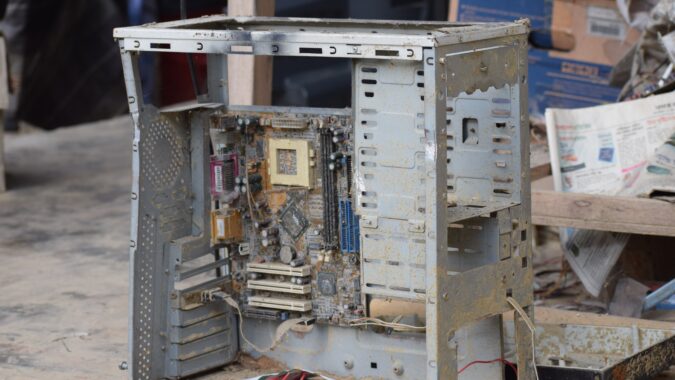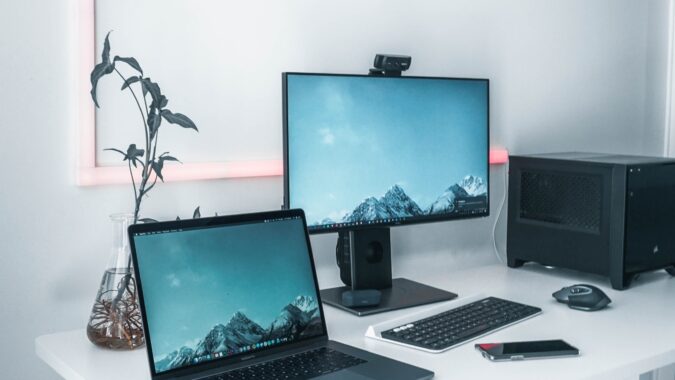
How to Recycle Computers
Computer recycling is an easy and environmentally friendly way for businesses and households to get rid of old machines. You can recycle computers including desktop PCs, MacBooks, and laptops that are broken or no longer needed to avoid them ending up in landfill. This helps protect the planet and saves your company money.
The Waste Electric and Electronic Equipment (WEEE) Regulations 2013 cover the disposal of computers. Businesses must therefore recycle any old computer where possible to ensure it’s disposed of safely and in a way that causes as little harm to the environment as possible. Plus, recycling computers protects your organisation’s green image and credentials.
Learn how to recycle computers from your business or home in this guide. For a free quote for computer waste collection and recycling contact us online or call 0800 211 8390 today.
Contents
How to recycle old
computers and laptops
Old computers and laptops are a type of Waste Electrical and Electronic Equipment (WEEE). This means they should be recycled and never disposed of with general waste by households or businesses. Recycling computers and laptops avoids them ending up in landfill, where the chemical and plastic elements they contain can leach into the ground and contaminate plants and water sources.
How to recycle a laptop or computer depends on if you’re getting rid of it as a business or consumer:
How to recycle old
computers as a business
The WEEE Regulations 2013 dictate that businesses are responsible for financing the collection, treatment, and recovery of any e-waste they produce. This includes computers, laptops, and any other IT equipment that has a plug, uses batteries, or needs charging. To recycle computers as a business you must arrange commercial waste collection.
Use a professional waste management service for recycling computers your business no longer needs – whether they’re old or broken. This ensures your old computers are removed by licensed waste carriers and taken to a relevant recycling facility where as much of the materials will be recovered, reused, and recycled as possible.
Your business will receive a duty of care certificate to show your old computers were recycled in line with the WEEE regulations and any other relevant legislation. Commercial waste collections provide the easiest and safest way to recycle old computers from any business.
How to recycle old
computers at home
When you buy any new electrical item in the UK (including a PC, Mac, or laptop), the retailer is legally obliged to help you safely and responsibly recycle the one being replaced. This is often through the Retailer Take-back Scheme (RTS), where you can drop off your old computer in-store.
There are more than 10,000 stores in the scheme, and you don’t have to return it to the original store where you purchased the computer. Some retailers use the Distributor Take-back Scheme (DTS), where local councils collect electrical waste on the retailer’s behalf.
Either service should be available for free, or the retailer must contribute to the cost of local recycling services. Check the information and services available at a store near you to recycle your old personal computer or laptop.
What is the computer
recycling process?
Computers and laptops are made from a combination of different materials including plastic, metal, glass, and precious metals. Most computers are made from up to 23% plastic but can also contain toxic substances such as lead, mercury, cobalt, and more. Safely separating all elements is vital to recycle computer parts efficiently.
Once old computers are collected, they’re transported to a recycling centre for processing. The exact steps can vary between facilities, but the general computer recycling process is:
- Sorting – old computers are sorted by their type and separated for processing. Computers with cathode ray tubes (CRT) are sent for processing in one line, for example.
- Testing – depending on the facility, the computers and parts may be tested. If they still work and are in decent condition, they may be sent for upgrading and refurbishing, rather than recycling. These refurbished computers are then sold or donated.
- Disassembling – the main computer components are removed, such as the speakers, circuit board, sound and graphics cards, and hard disks. Normally this is done manually to ensure such computer parts can be reused and sold to computer manufacturers.
- Separating – further dismantling and separating of components follows with the plastics, ferrous and non-ferrous metals, and CRT elements. The CRT parts contain types of hazardous materials including lead, cadmium, mercury, phosphors, and barium. These are then sent to special facilities to remove the likes of lead from the CRT glass panel.
- Data destroying – hard drives and processors are shredded to ensure all data is destroyed. This waste can then be recycled into aluminium ingots and used in the automotive sector.
- Shredding – after all useful and hazardous computer parts are recycled, the rest is separated by material and shredded. This includes any plastic casing, wires, circuit boards, and other metals. It’s then screened and precious metals may be smelted – both processes help remove any valuable components.
- Reusing – any recovered materials such as plastics, glass, and metals are sent to specific material recyclers for further processing. These materials are reused to manufacture new products, such as to create fresh steel and metallic products.

What to do before
recycling a computer
Before you recycle a computer from your home or business there are two important things to do – back up your data and wipe the hard drive. This ensures you maintain all the key files, information, and data you need from your old computer and that nobody should get their hands on any sensitive or personal information.
You can back up the data on an external hard drive, USB stick, server, or cloud storage. Check that you can access it and that everything is secure. Once you’re certain it’s all backed up you should then use the factory reset option to wipe your computer.
If you want to be extra safe you can remove the hard drive for safekeeping or destruction. Computer cleaning kits are also available, but you only really need to consider using one when you plan to resell your old computer or its parts.
Why is it important to
recycle old computers?
Recycling old computers is important to prevent them ending up in landfill. If old computers go to landfill, then chemicals from the plastics and other hazardous materials contained in them can leach into the ground, air, and nearby water. This negatively affects the local environment and adds to pollution levels and CO2 emissions.
When computers aren’t recycled then new materials are also required to create fresh IT equipment. This requires lots of energy and the use of raw materials, which can damage natural habitats. Computer recycling uses much less energy and materials to manufacture new computers, which also reduces greenhouse gas emissions.

Where can you
recycle computers?
Depending on whether you need to get rid of a computer from your business or home there are various ways to recycle computers. The main places where you can recycle computers are:
- Returning it to a retailer – many high-street retailers that sell electronic goods accept old computers for recycling, whether you bought it there originally or not.
- Calling the computer manufacturer – most computer manufacturers have returns programs that accept old machines that they arrange recycling for.
- Visiting your local household waste recycling centre – lots of HWRCs have WEEE bins and sometimes separate bins for old computer recycling.
- Donating your old computer to a charity shop – if your old PC still works then many charity shops or community projects may accept it to use or sell.
- Reselling online – Facebook Marketplace, eBay, and Gumtree are popular websites to sell old computers and parts whether they work or not.
- Arranging collection from your business – companies and organisations can arrange commercial waste collection of old computers by professional waste management firms to ensure they’re recycled.
Ways to reduce
computer waste
The main way to reduce computer waste is to hold onto working computers and laptops for longer and avoid throwing them out. If a computer still works then consider upgrading its parts – such as the graphics, sound cards, and processor – rather than buying a brand-new machine. This reduces the need for new materials, prevents waste, and saves you money.
Another key action to minimise computer waste is to donate old machines rather than send them for recycling. Many charities and community projects will accept working PCs to sell or use. Even if your old computer is broken, some charities and individuals will take them to repair and then use or sell it.
Arrange computer
recycling collection
Send any old computers from your business for recycling with Business Waste. We provide free bins and containers of various sizes to store computers, IT equipment and any type of WEEE waste on-site. You just pay for collection and our licensed waste carriers will remove it at an agreed time.
They’ll transport your old computers to a nearby waste management facility for safe and legal recycling. You also receive a free duty of care certificate for peace of mind that your old business computers are recycled. Arrange collections as a one-off or on a daily, weekly, or fortnightly basis wherever you’re based in the UK.
Get a free quote for computer waste collections whatever your industry. Contact us online or call 0800 211 8390 and one of our friendly team will provide a no-obligation quote tailored to your needs.

Get a free quote for computer recycling
Get a fast FREE quote for computer waste collections
- Free quote within 1 hr
- Any type of computers
- FREE bins and delivery
- We cover all of the UK
Learn more about
computer recycling
Computer recycling FAQs
-
How do you remove the hard drive from a computer before recycling it?
To remove the hard drive from a computer or laptop before recycling you’ll need a screwdriver and a set of pliers. You must know what the hard drive looks like before you start to ensure you don’t remove another part by accident. How to remove a hard drive differs between computers and laptops:
- Computers – remove the enclosure side of the computer case. The hard drive is normally a rectangular box with the manufacturer’s name and the drive’s storage capacity on a label. Use a screwdriver to remove the bracket and take out the hard drive.
- Laptops – laptops often place the hard drive in different positions, so it’s best to read the instruction manual to find where it is. Normally you’ll need to remove the battery first and then unscrew the hard drive access panel before you can take it out.
-
Can you destroy a hard drive with a hammer?
Hitting a hard drive with a hammer will destroy it. The hard disk or hard disk drive platter is the part that stores digital data. These are normally made from glass, ceramic, or metal, so smashing them hard enough with a hammer should break them and destroy the data it stores.
-
Who needs computer recycling?